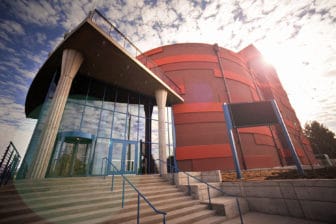The Round Up/Oncore Magazine recently sat down with Dustin Chavez, president of the Associated Students of New Mexico State University, to discuss what issues will be brought before the 2016 New Mexico Legislature, which begins on Jan. 19 and goes through Feb. 18.

Nathan Kramer / NMSU
The ASNMSU Center for the Arts on the main campus of New Mexico State University in Las Cruces.
The biggest issue at hand right now for students is the state of the Lottery Scholarship.
“One of the hot topics this year that I (and others) feel very passionately about is the Lottery Scholarship,” Chavez says. “Right now the Lottery Scholarship is funded at 90 percent, but if nothing happens soon, in 2017 it will be funded at around 60 percent.”
Chavez says stretching the Lottery funds to meet the financial needs of students “is a big issue,” which is why this legislative session, ASNMSU is focusing on back-loading, which refers to students receiving fully funded senior years, or 100 percent of the scholarship, while receiving lesser amounts in their junior, sophomore, and freshman years.
Another topic Chavez wants to bring before the Legislature is allowing students to take a year off between high school graduation and starting college and still receiving the scholarship. By permitting this, students would be able to decide more clearly if they even want to go to college, and if not, the scholarship funds could be put to better use in funding a student who does and will graduate.
In the hopes that these issues are also relevant to the other four-year state schools in New Mexico, Chavez says he is planning a meeting with student body presidents and school presidents from across the state.
“All of the four-year institutions have been invited,” he says. “But we are having a council of university presidents to better establish what the state, as a whole, wants so we can push and better advocate for (those things),” says Chavez.
Of particular interest to NMSU students are the capital outlay projects, funding for which Chavez plans to request of the Legislature.
“Right now we don’t have (an exact) number, but we have about $350,000 in capital outlay requests,” he says. “One project will be renovations to the locker rooms in the Activity Center, because they haven’t been renovated since it was built.
These renovations will cost about $150,000, Chavez says.
“Then, about $175,000 for the crosswalk by Kinko’s,” Chavez says. “We want to put in a system to make it safer for students to cross, to utilize the businesses as well, and to get more pedestrian traffic on campus.”
ASNMSU has partnered with the City of Las Cruces to complete the crosswalk project.
When ASNMSU goes to the New Mexico Legislature, a body of students will go to Santa Fe to lobby. The students often stay in Santa Fe for weeks on end. This has enabled them to form some great relationships with politicians and policymakers.
Chavez talked about how having a former governor of New Mexico — Garrey Carruthers — as president of the university helps ASNMSU and NMSU interests at the legislative session.
“It’s great having someone who knows how to work the Legislature,” Chavez says. “Watching him work a room is something that you don’t see very often. The other thing that is really great about President Carruthers and NMSU’s history is that they are always very responsive to the students. Whatever the student government backs, they will typically back as well. They also give us quite a bit of freedom to operate.”
Chavez says ASNMSU works on national papers with other student governments to present to Congress and the White House.
“So our voice is being heard on the state level and nationally, which is nice,” he says.
About ASNMSU
ASNMSU is one of the largest student body governments, by funds and amount of power, Chavez says.
“If you ranked (student governments) by most employees and funds managed, as well as power on campus, the order would be: ASNMSU, ASUNM (of Albuquerque), and New Mexico Tech Student Government Association,” says Chavez. “Nationally, we are one of the larger student governments. The amount of money that we appropriate through senates is not really common in most schools.”
ASNMSU’s budget is appropriated through the General Appropriations Act.
“(Student) Senate sits down yearly, like the (U.S. Government), and makes the budget,” he says. “They add things and cut things until eventually it ends up on my desk to be signed into law.”
This year, the GAA outlines a budget of more than $1.1. million.
“The only thing to keep in mind about the GAA is that it is a guideline,” says Chavez. “We can spend up to that much, but with my background in accounting and finance, I’m hard and fast on the numbers to make sure we come in under-budget to build up our surplus accounts.”
ASNMSU is made up of students in a range of majors, from criminal justice to political theory. Students who are enrolled full-time and pay the ASNMSU fee can vote for running candidates whenever elections are held.
ASNMSU operates according to the decrees in a law book called the Constitution of Associated Students of New Mexico State University. The constitution outlines the separation of branches and their respective powers and duties in ASNMSU. The three branches of ASNMSU are the legislative, executive, and judicial branches.
The legislative branch is in charge of passing legislation and must meet at least once every two weeks of the fall and spring semesters.
The judicial branch helps interpret the laws and policies, and solve disputes in its courts.
Chavez, who is in charge of enacting laws and policies not specifically required of other branches, heads the executive branch of ASNMSU. He is also in charge of nominating and appointing members of ASNMSU to fill executive offices.
